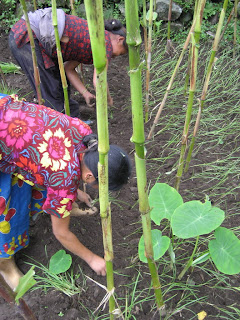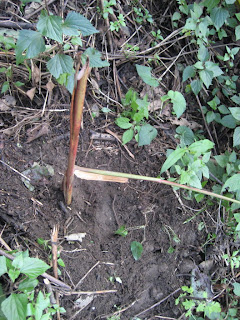Project changes...
"It is not unusual for research plans to change after one begins fieldwork. A range of factors may alter one's carefully made plans, including the absence of expected economic institutions, local resistance to research objectives, state or other political intervention, and so on....So many ethnographies begin with a statement along the lines of 'I went to study A, I ended up studying B'. " (Gregory and Altman 1989:44 - "Observing the Economy")
My first post on this blog described research I was planning to carry out in Sikkim, with the Lepcha, on "Medical Culture". Having recently returned from Nepal after 8 months of fieldwork in a village there, my research is now: in East Nepal, with the Limbu, on the "Political economy of cardamom"! A major shift, though it still has something to do with plants (one plant!), and something to do, loosely, with health (one of the major uses of cardamom is in Ayurvedic remedies, though interestingly the villagers in Nepal who sell the seeds never use it themselves).
Pasted below is a short brain-storm of the new things that I became interested in whilst living in Mamangkhe, Taplejung:
What I’m interested in:
1. Cardamom:
1.1. History of cardamom in Mamangkhe; in Taplejung; and in Nepal/Sikkim more generally [I have photocopied 8 MSc theses (economics and geography) from Tribhuvan University in Kathmandu which focus on cardamom cultivation in Nepal].
1.2. Technologies and techniques; knowledge of cardamom and ecology of forest; knowledge of what affects cardamom production (soil types, rainfall, etc.); are there people with more expertise or skill and where did they get this from – transmission of knowledge and experimentation and development of new techniques.
1.3. Economy of cardamom: economic and labour cost of production; market chains (selling cardamom); distribution and use of profits; enterprise, management
1.4. Ecology of cardamom: different forest/land types and their relative productivity; distribution of land types among families (this ties into section 3 below);
2. Class formation:
2.1. The histories of families that have moved away from Mamangkhe or partially-moved to Jhapa.
2.2. Competitiveness within the village as the tourist industry develops. People who can provide services to tourists (lodges, food, portering), often people who have bought houses by the main trail through the village, benefit rapidly and tremendously from this.
2.3. Land location and class: there is a probable relationship between physical location of land within the village and economic “position” or class. Tied to points 2.2 and 3, people who live by the main trail have often been able to buy property there from high-caste Nepalis who left in the last few decades. These houses are often large and modern (i.e. tin-roofed) with enough space to provide accommodation to tourists, porters and villagers passing-through. All village’s facilities are on the main trail: the school, health post, telephone, museum (which incorporates meeting rooms and, more recently, a computer), and all the shops from which villagers can buy basic essential goods (cooking oil, salt, soap). Houses located further above or below the main trail, sometimes up to 1 hours walk from the main trail, are visited less frequently by other villagers and tend to belong to somewhat poorer families (though this is of course not always the case).
3. Land use:
3.1. History of land use: some parts of the village which were previously agricultural -used for maize, rice and millet production - have been replanted with cash-crop cardamom and shade-producing trees. In other areas these basic crops have continued to be grown as it is important to produce a certain amount of ones own food.
3.1.1. What influences land use decisions;
3.1.2. What determines the kinds of land people have access to, inherit, or are able to buy or farm on;
3.2. Work on land:
3.2.1. Different work arrangements including adyiā, Tekā, bāndhoki;
3.2.2. How large land-owners distribute labour tasks to others in the village;
3.2.3. How land-owners who live outside Mamangkhe (Taplejung, Panchthar, Ilam, Jhapa) relate to their village, the land, and supervise production (similar to 3.2.2);
4. Migration:
4.1. Migration from the village: historical movement out of village by high-caste Nepalis; more recent movement out of village by Limbus.
4.2. Temporary migration out of village: Families often move away from the village when the bread-winner goes abroad for long-term or seasonal work. This may involve moving to the mother or wife’s family home, or, in the case of around 15 households, moving to Jhapa. Several families live in temporary accommodation with no agricultural land and are uncertain about their future: if the husband returns with money saved, they can buy a property in the area and stay more permanently (4.1); if they have made no money they must return to the village (Mamangkhe) and pay back their debts.
4.3. Incentive to migrate: Many people cite the isolation and need to personally carry goods into the village from Tharpu (2 days walk away) as the major reasons why they would want to leave the village. Other reasons include bad health services and lack of a good education for their children. There is currently a road being built which will reach Mamangkhe within the next 5 years (supposedly). It is interesting to speculate on how this will affect migration, perhaps by looking at villages that the road has recently reached, like the village of Tellok, about 8 hours walk downstream.
What I have collected so far:
1. Survey of 201 households in Wards 1 to 7, Mamangkhe. Data on demography, education, language, economics (production/consumption/conspicuous consumption), cardamom, travel, health and religious activities.
2. Survey of 30 households in Aitabare and Happenchowk, in Jhapa district. Semi-structured interviews on similar subjects as the survey in Mamangkhe but included questions on past employment (where/how they made enough money to move down), house and land prices at the time of purchase/building, education of children (private boarding schools), motivations and perceptions of difference between up (Mamangkhe) and down (Jhapa).
3. Structured interviews with older men in the village (a total of 6) on the topic of personal, village and Limbu history.
4. Informal unstructured interviews with 8 local phedangma (shamans)
5. Participant-observation throughout my work in the village. This included work experience during every agricultural task from planting and weeding rice, ploughing terraces, clearing forest, picking cardamom, cutting trees, planting maize, setting up fish traps and fishing, etc. As well as involvement in any important local ritual or ceremony such as marriages, funerals, the museum opening, etc.
6. Over 2000 photographs and 200 video clips of all of the above (5) which have been categorised and labelled.
7. Over 150,000 words of field-notes.




















































